We’ve been talking a lot lately about how important it is to select the right Pipette Dispensing System to enhance your customers’ experience. If your product is in liquid form and you need to provide control and consistency, it’s extremely likely that you are going to turn to a Dropper Pipette for dispensing your product.
But once you have decided to use a pipette system to dispense your product, you need to make sure you combine the right components to avoid any leaks, breakage, damage, or lost inventory. To help our customers, we created post addressing how to choose the right material for your components, like whether to choose a glass or plastic pipette. We also shared how a knowledgeable, experienced supplier can help guide you and provide value in so many ways.
To help our customers further, we created a checklist of the important questions you need to ask to hone in on the right Dropper Pipette Dispensing System. Spending 15 minutes in this upfront assessment can save you hours and even days identifying the correct packaging. If you still aren’t sure which dispensing components to buy after you have gone through the questions, just give our Solution Specialists a call. They are knowledgeable and experienced and will get you to the ideal solution quickly.
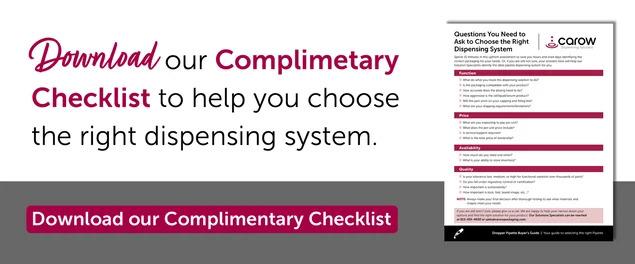
Questions to Ask to Choose the Right Dispensing System
To help you think through how to choose the right dispensing system for your product, we have collected a list of questions to guide you in your decision. The questions fall into four categories – Function, Price, Availability, and Quality.
Function
The first factor to consider revolves around how you need your dispensing system to function. For example, how much liquid does the dropper need to hold? Is accurate dosage essential? For a refresh on the three components of a dispensing system – caps, bulbs, and pipettes – read this.
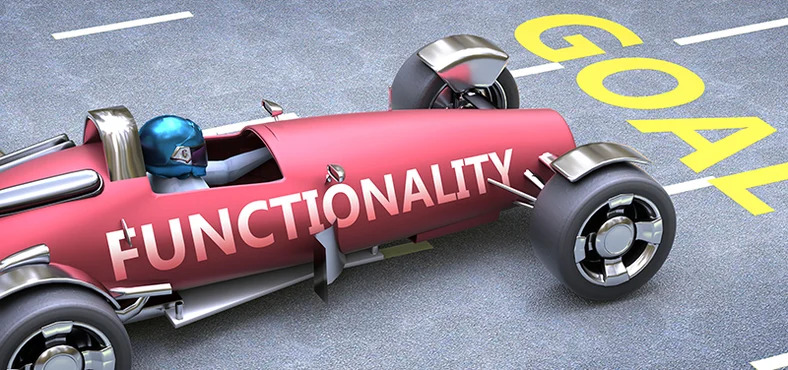
- What do you need this dispensing solution to do? Does it need to dispense small, accurate drops? Does it need to meet any regulatory safety requirements?
- How much capacity do you need? This will determine the bottle size and the length of the pipette.
- How accurate does the dosing need to be? Do you need to have dosage markings on the pipette? Or is your product used for flavoring, which is up to individual taste preference?
- How aggressive is the oil/liquid/serum product? What is the chemical make-up of your beauty serum, for example? This question may lead you to choose a specific bulb or pipette material.
- Will every part of the system work on your production line? If you automate the capping and filling process, this is one of the most important questions. Request samples of the components before making any final decisions to ensure compatibility with your capping and filling line. (We are always happy to provide samples.)
- Is a part compatible with your product? Certain bulb or cap materials do not react well when they come into contact with essential oils or serums. Take the time to understand which material works best with the nature of your product.
- What are your shipping requirements/ limitations? Does your product need to be a certain weight or size to fit with your logistical requirements?
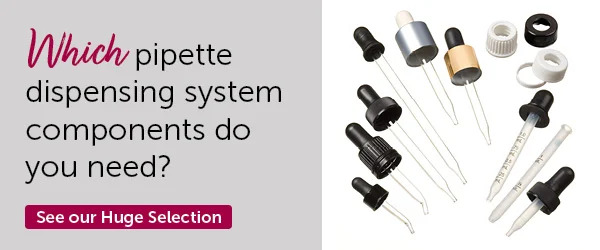
Price
Price is another important consideration when deciding on the right pipette dispensing system. When evaluating your options, don’t forget to take into consideration the Total Cost of Ownership for your system. Meaning, some individual items may appear to be less expensive from other vendors but depending on the supplier, you need to factor in overseas shipping costs, long lead times, inventory holding costs, and exchange rates. The end cost could be higher than you think.
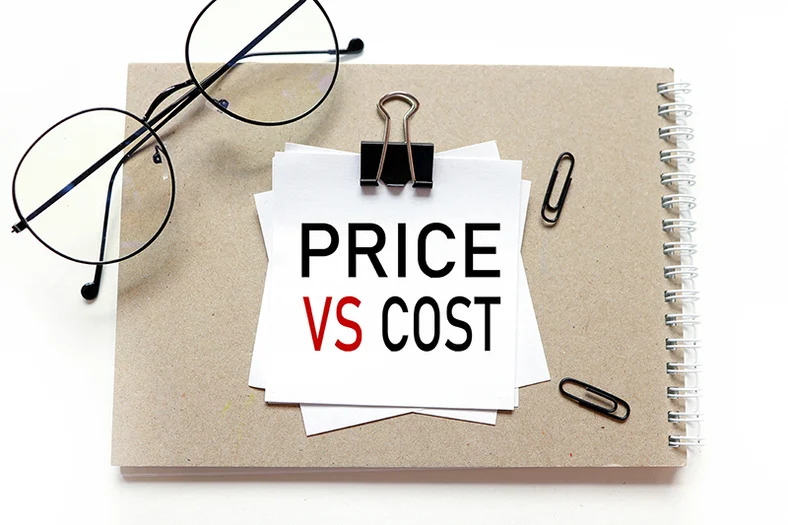
- What are you expecting to pay per unit? Are you aiming for a specific target margin or end user price?
- What does the per unit price include? Are there any hidden costs that may affect the Total Cost of Ownership?
- Is service/support required? What value do you place on having access to knowledgeable domestic customer service should your product be damaged during shipping or not seal correctly in your capping machine?
- What is the total price of purchase? In addition to some of the Total Cost of Ownership costs we listed, have you factored in breakage, or the opportunity cost of shipping delays or production shut-downs, or product replacement costs due to excessive leakage?
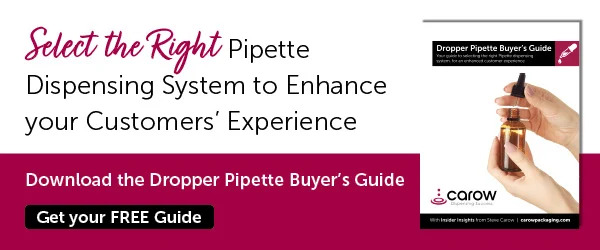
Availability
To be able to get your product on the shelf or to the distributor/retailer when THEY need it, you need to work with a supplier that can get you packaging when YOU need it. If your company relies on a huge fourth quarter from Holiday or year end sales, you don’t want to miss out on sales opportunities because you didn’t have pipettes, caps, or bulbs. Especially with the global shipping challenges going on this year, one of the first questions you should ask is how quickly you can get the product. Are any components made in the USA, giving you faster delivery times and more reliable shipping estimates?

- How much do you need and when? Forecasting is so important to be able to answer this question. Our Solution Specialists are well versed in forecasting and we help a lot of our customers answer this question and place the appropriate orders.
- What is your ability to inventory? If your packaging products have a really long lead time or if you are concerned about the accuracy of your forecast and don’t want to be short on your packaging components, you might need to order more than you immediately need and hold the product in inventory. Can you do that in your facility? Or will you have to incur an unforeseen storage or warehousing cost that will affect your profit margins?
Quality
How important is the quality of your packaging components? Everyone wants quality products but, in many cases, higher quality product cost more. If cost is a factor, it might be helpful to determine the minimum acceptable quality level needed for your product.
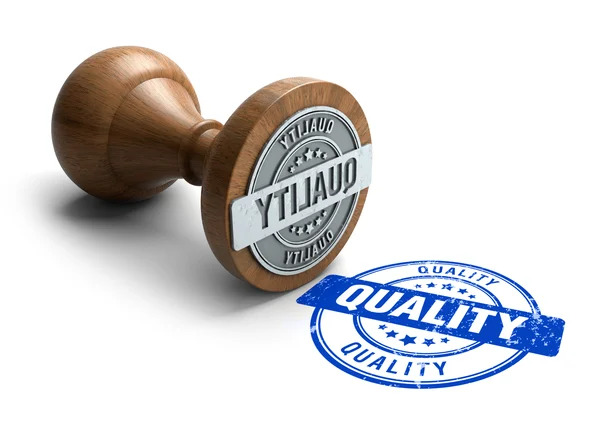
- Is your tolerance low, medium, or high for functional variation over thousands of parts? This is often dictated by the level of automation in your filling process. Technically advanced machines, for example, are precisely calibrated and minor variances can shut down a line.
- Do you fall under regulatory control or certification? There are regulations required for certain liquids as noted by the Poison Prevention Packaging Act and administered by the Consumer Product Safety Commission (CPSC). When it comes to CBD products, pharmaceuticals, food flavorings, and even some beauty serums, there may be other regulatory agency requirements.
- How important is sustainability? Glassware is capable of reuse after prescribed cleaning, which appeals to sustainability-conscious consumers. If your company is implementing a return and reuse program for your product packaging, you may want higher quality materials suitable for longer term use and cleaning.
We hope these questions help you make the right decision for your dropper pipette dispensing system. Feel free to download these questions in our handy checklist.
If you are still aren’t sure what you need, please give us a call. We are happy to help your narrow down your options and find the right solution for your product. Our Solutions Specialists can be reached at 815-455-4600 or sales@carowpackaging.com.